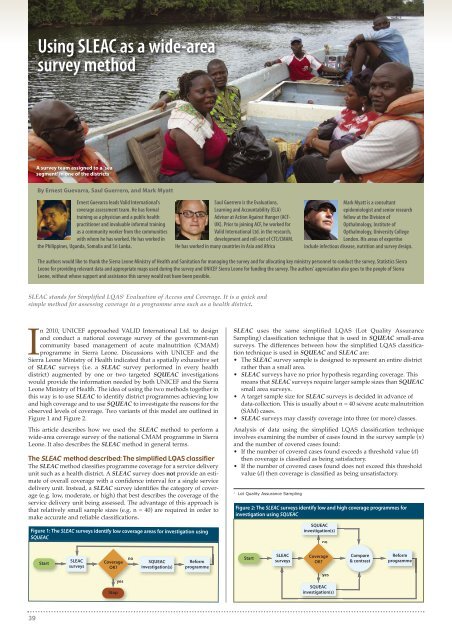Download a PDF of this issue - Field Exchange - Emergency ...
Download a PDF of this issue - Field Exchange - Emergency ...
Download a PDF of this issue - Field Exchange - Emergency ...
You also want an ePaper? Increase the reach of your titles
YUMPU automatically turns print PDFs into web optimized ePapers that Google loves.
Using SLEAC as a wide-area<br />
survey method<br />
A survey team assigned to a 'sea<br />
segment' in one <strong>of</strong> the districts<br />
By Ernest Guevarra, Saul Guerrero, and Mark Myatt<br />
Ernest Guevarra leads Valid International's<br />
coverage assessment team. He has formal<br />
training as a physician and a public health<br />
practitioner and invaluable informal training<br />
as a community worker from the communities<br />
with whom he has worked. He has worked in<br />
the Philippines, Uganda, Somalia and Sri Lanka.<br />
Saul Guerrero is the Evaluations,<br />
Learning and Accountability (ELA)<br />
Advisor at Action Against Hunger (ACF-<br />
UK). Prior to joining ACF, he worked for<br />
Valid International Ltd. in the research,<br />
development and roll-out <strong>of</strong> CTC/CMAM.<br />
He has worked in many countries in Asia and Africa<br />
Mark Myatt is a consultant<br />
epidemiologist and senior research<br />
fellow at the Division <strong>of</strong><br />
Opthalmology, Institute <strong>of</strong><br />
Opthalmology, University College<br />
London. His areas <strong>of</strong> expertise<br />
include infectious disease, nutrition and survey design.<br />
The authors would like to thank the Sierra Leone Ministry <strong>of</strong> Health and Sanitation for managing the survey and for allocating key ministry personnel to conduct the survey, Statistics Sierra<br />
Leone for providing relevant data and appropriate maps used during the survey and UNICEF Sierra Leone for funding the survey. The authors' appreciation also goes to the people <strong>of</strong> Sierra<br />
Leone, without whose support and assistance <strong>this</strong> survey would not have been possible.<br />
SLEAC stands for Simplified LQAS 1 Evaluation <strong>of</strong> Access and Coverage. It is a quick and<br />
simple method for assessing coverage in a programme area such as a health district.<br />
In 2010, UNICEF approached VALID International Ltd. to design<br />
and conduct a national coverage survey <strong>of</strong> the government-run<br />
community based management <strong>of</strong> acute malnutrition (CMAM)<br />
programme in Sierra Leone. Discussions with UNICEF and the<br />
Sierra Leone Ministry <strong>of</strong> Health indicated that a spatially exhaustive set<br />
<strong>of</strong> SLEAC surveys (i.e. a SLEAC survey performed in every health<br />
district) augmented by one or two targeted SQUEAC investigations<br />
would provide the information needed by both UNICEF and the Sierra<br />
Leone Ministry <strong>of</strong> Health. The idea <strong>of</strong> using the two methods together in<br />
<strong>this</strong> way is to use SLEAC to identify district programmes achieving low<br />
and high coverage and to use SQUEAC to investigate the reasons for the<br />
observed levels <strong>of</strong> coverage. Two variants <strong>of</strong> <strong>this</strong> model are outlined in<br />
Figure 1 and Figure 2.<br />
This article describes how we used the SLEAC method to perform a<br />
wide-area coverage survey <strong>of</strong> the national CMAM programme in Sierra<br />
Leone. It also describes the SLEAC method in general terms.<br />
The SLEAC method described: The simplified LQAS classifier<br />
The SLEAC method classifies programme coverage for a service delivery<br />
unit such as a health district. A SLEAC survey does not provide an estimate<br />
<strong>of</strong> overall coverage with a confidence interval for a single service<br />
delivery unit. Instead, a SLEAC survey identifies the category <strong>of</strong> coverage<br />
(e.g. low, moderate, or high) that best describes the coverage <strong>of</strong> the<br />
service delivery unit being assessed. The advantage <strong>of</strong> <strong>this</strong> approach is<br />
that relatively small sample sizes (e.g. n = 40) are required in order to<br />
make accurate and reliable classifications.<br />
Figure 1: The SLEAC surveys identify low coverage areas for investigation using<br />
SQUEAC<br />
SLEAC uses the same simplified LQAS (Lot Quality Assurance<br />
Sampling) classification technique that is used in SQUEAC small-area<br />
surveys. The differences between how the simplified LQAS classification<br />
technique is used in SQUEAC and SLEAC are:<br />
• The SLEAC survey sample is designed to represent an entire district<br />
rather than a small area.<br />
• SLEAC surveys have no prior hypothesis regarding coverage. This<br />
means that SLEAC surveys require larger sample sizes than SQUEAC<br />
small area surveys.<br />
• A target sample size for SLEAC surveys is decided in advance <strong>of</strong><br />
data-collection. This is usually about n = 40 severe acute malnutrition<br />
(SAM) cases.<br />
• SLEAC surveys may classify coverage into three (or more) classes.<br />
Analysis <strong>of</strong> data using the simplified LQAS classification technique<br />
involves examining the number <strong>of</strong> cases found in the survey sample (n)<br />
and the number <strong>of</strong> covered cases found:<br />
• If the number <strong>of</strong> covered cases found exceeds a threshold value (d)<br />
then coverage is classified as being satisfactory.<br />
• If the number <strong>of</strong> covered cases found does not exceed <strong>this</strong> threshold<br />
value (d) then coverage is classified as being unsatisfactory.<br />
1<br />
Lot Quality Assurance Sampling<br />
Figure 2: The SLEAC surveys identify low and high coverage programmes for<br />
investigation using SQUEAC<br />
SQUEAC<br />
investigation(s)<br />
no<br />
Start<br />
SLEAC<br />
surveys<br />
Coverage<br />
OK?<br />
Stop<br />
yes<br />
no<br />
SQUEAC<br />
investigation(s)<br />
Reform<br />
programme<br />
Start<br />
SLEAC<br />
surveys<br />
Coverage<br />
OK?<br />
yes<br />
SQUEAC<br />
investigation(s)<br />
Compare Reform<br />
& program contrast<br />
Reform<br />
programme<br />
39
















